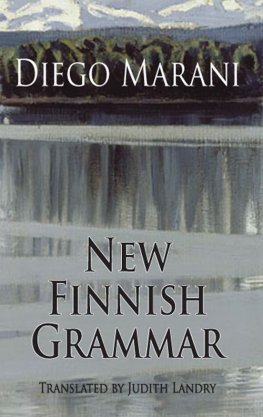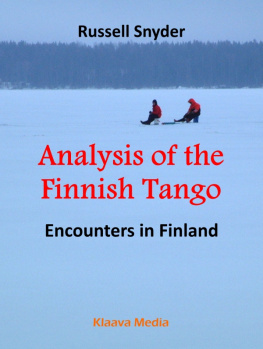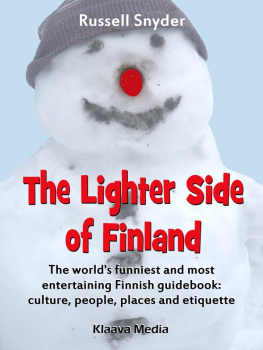Content
Preface
- The purpose of this book
This book is a manual of the Finnish language, describing its features and difficulties in addition to the basic grammar, word derivation information, spelling and style guidance, etc . This is not a textbook but a reference. The idea is that you can use the book to check specific issues in Finnish that are important to you in some occasion. For example, a reader with limited or maybe no previous knowledge about Finnish can consult this book to find information about a particular phenomenon or language form in Finnish, about the way to write some notation in Finnish, or about some specific difficulty in translating into Finnish.
However, the book can also be read systematically to get a more thorough understanding of Finnish and to find new interesting possibilities or pitfalls in the language. For this, you probably need to know Finnish well enough to read simple newspaper text or to use Finnish in simple everyday conversation.
In principle, no previous knowledge is assumed, but in practice, most people would find this book hard to read if they do not know Finnish at all unless they are linguists or polyglots . The problem would be lack of motivation and general framework. For example, due to the systematic approach, the book has a long discussion of variation of word stems and suffixes before it deals with specific suffixes and their meanings.
2. The scope of this book
The Finnish language described in this book is primarily standard written Finnish, but common features of spoken Finnish are presented both as a summary and in the context of normal presentation of the grammar. In addition, widespread language errors (i.e., deviations from language norms) are discussed, since the purpose is also to help to understand written and spoken language in the wild.
The book also covers many topics that most grammars do not deal with, such as details of pronunciation, adaption of foreign words into Finnish, various notational conventions that differ from those used in English, and even dialects and poetic language.
The vocabulary of a language, including information about the inflection patterns, as well as the use of phrases belongs to dictionaries and phrase books rather than a manual like this. However, this book contains some information about vocabulary, including word derivation and composition . It also describes forms of common word s as used in spoken language, since these are not that well covered in dictionaries. Moreover, meanings of example words are often given in parentheses, when this seems to be relevant to understanding the general description. Consulting a good dictionary is useful, though, especially since the descriptions of meanings in this book are very brief.
3. Suggestions to different types of readers
Even people who speak Finnish well, perhaps as their native language, may find this book interesting. An analysis of a language feature may give you a deeper understanding of something that you use fluently at the practical level. Moreover, such understanding helps a native speaker of Finnish to avoid language errors when speaking a foreign language: we all tend to use features of our native language in other languages, too. This book also describes features that are not in widespread use in modern language but help you to understand older texts and maybe to enrich your own texts wi th carefully used old Finnish.
In particular, this book documents phenomena that are common in Finnish but generally not described in textbooks or grammars. For example, actual pronunciation of foreign names in Finnish often greatly differs from the instructions given in encyclopedias and other sources.
People learning Finnish at an early phase may find descriptions in this book useful for orientation, for explaining background, and especially for dealing with complicated phenomena, such as word inflection. Language learning is both cumulative (you just add new words, phrases, etc., to the repertoire you have) and perceptional (you learn completely new concepts and ideas). This book mainly helps with the latter, though as an aside, you will learn new words as well.
People whoknowFinnishwell can read this book systematically to improve their command of the language , written and spoken . This is useful especially to people who have mostly learned the language by the natural method. T his book can be also used as a reference book when you are uncertain about some features of the language.
Translators, interpreters, and localizers can use this book as a reference to Finnish grammar, orthography, and to some extent style. This book discusses both normative rules of Finnish and common usage; the latter may be relevant e.g. when translating informal material or dialogues .
4. The structure of this book
This book is divided into numbered sections grouped into chapters. Within each section, and even each subsection, the presentation proceeds from simple descriptions to finer details and exceptions, if possible. In systematic reading, if you find some topic covered in more detail than you care about on first reading, just skip to the next section (or subsection).
The overall structure of this book is the following:
- First, some general information about Finnish is presented for orientation , in chapters Historical and cultural background and Key features of Finnish. The latter describes principles of using suffixes, phenomena like variation in word stem in inflection, and other general concepts and principles. Many features are described here at the general level, to be repeated in more concrete forms later.
- The chapter Pronunciation and writing then describes the rules for writing and pronunciation, covering differences between them in detail. It also presents punctuation rules and special writing rules applied in various notations, such as dates and monetary quantities.
- The vocabulary is described next. For practical reasons, this part consist s of three chapters: Vocabulary, Word derivation, and Compound words .
- Then th e parts of speech are described, in chapters N ouns , A djectives , Adverbs, Pronouns, Numerals, Particles, and Word-like suffixes ". The description includes both the formation of inf lected forms and their meanings and use. Intermixed with the presentation of parts of speech, there are two chapters Singular and plural and P ossessive suffixes , which would be differently placed in a purely logical order.
- Higher-level structural issues like word order and subclauses are discussed in chapter Sentence structures . It also includes things like the choice of the case form of an object, one of the tough parts for advanced learners.
- After this systematic presentation, some additional topics are covered. First, chapter Poetic features describes phenomena like alliteration, described as something appearing in normal prose, too, rather than as poetry proper.
- Chapter Spoken Finnish describes first common sp oken Finnish, a language form that you normally hear in TV, public discussions, and everyday language when it lacks specific dialect features. Then some key features of major dialects are described.
- The last of the normal chapters, Language technology and Finnish describes technical aspects, such as writing Finnish on a computer, typesetting Finnish texts, and translation and localization issues specific to Finnish. The chapter starts with an executive summary of the topic, designed to be readable as standalone, too.
- The remaining chapters are appendix-like: Suffix glossary, which is an index to derivation, inflection, and other suffixes; Inflection classes, which lists the inflection types of noun-like words and verbs; Compositive forms of verbs, which covers a large number of forms of verbs used in compound words; Proper names, which lists Finnish forms of foreign proper names, with English equivalents and some explantations; Abbreviations, which lists the commonly used (and some less common) abbreviations; Style settings for Finnish in Word, which has information that is otherwise very difficult to find; References, which describes essential reference material on Finnish, mostly in Fin nish, in printed or online form; and Finnish grammar terms, which lists Finnish-language terms used in Finnish grammars, with English equivalents.











